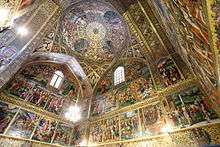Armenian art
| Part of a series on the |
| Culture of Armenia |
|---|
 |
| History |
| People |
| Languages |
|
Traditions |
|
Mythology and folklore |
| Cuisine |
| Religion |
|
Music and performing arts |
| Sport |
|
Monuments
|
|

Armenian art is the unique form of art developed over the last five millennia in which the Armenian people lived on the Armenian Highland. Armenian architecture and miniature painting have dominated Armenian art and have shown consistent development over the centuries.[1] Other forms of Armenian art include sculpture, fresco, mosaic, ceramic, metalwork, engraving, and textiles, especially Armenian carpets.
Prehistoric Armenia was home to the Urartu culture in the Iron Age, notable for its early metal sculptures, often of animals. The region was, as later, often contested by the large empires holding the nearby regions of Persia, Mesopotamia and Anatolia, and these all had considerable influence of Armenian art. The Armenians adopted Christianity very early, and developed their own version of Eastern Christian art, with much use of icons, Armenian miniatures in books, and the very original architecture of their churches and monasteries. A distinctive Armenian feature, which may have influenced the Medieval art of Europe, was the popularity from early on of figurative relief carvings on the outside of churches, unknown in Byzantium.
Armenians specialized in arts and crafts such as carpet-weaving.
Study of Armenian art history
The study of Armenian art began in the early 20th century. Notable scholars of Armenian art were Catholicos Garegin Hovsepian and professor Sirarpie Der Nerséssian.[1] More recently, Jean-Michel Thierry and Professor Dickran Kouymjian are prominent scholars of Armenian art.
Architecture
The first Armenian churches were built during the lifetime of St. Gregory the Illuminator, were often built on the sites of destroyed pagan temples, and imitated some aspects of Armenian pre-Christian architecture.[2]
Classical and Medieval Armenian architecture is divided into four separate periods.
The first period, from the 4th to the 7th centuries, began with Armenia's conversion to Christianity, and ended after the Arab invasions of Armenia. The early churches were mostly simple basilicas, some with side apses. By the 5th century the typical cupola cone in the center had become widely used. By the 7th century, centrally-planned churches had been built and the more complicated niched buttress and radiating Hrip'simé style had formed. By the time of the Arab invasions, most of what we now know as classical Armenian architecture had formed.
The second period lasted from the 9th to the 11th centuries. Armenian architecture underwent a revival under the patronage of the Bagratid dynasty with many buildings erected in the regions of Ani and Lake Van: these included both traditional styles and new innovations. Ornately carved Armenian khachkars were developed during this time.[3] Many new cities and churches were built during this time, including a new capital at Lake Van and a Cathedral on Akdamar Island to match. The Cathedral of Ani was also completed during this dynasty. It was during this time that the first major monasteries, such as Haghpat and Haritchavank were founded. This period was ended by the Seljuk invasion.
Miniatures

Illuminated manuscripts were produced in Armenia mainly between the 5th and the 17th centuries. The highest point of this art is associated with the 13th century and the name of Toros Roslin, considered to be the most prominent medieval Armenian manuscript illuminator. The majority of the manuscripts were lost, and scolarly approach to studies of Armenian illuminated manuscripts was only developed in the second half of the 20th century.[4]
Sculptures
Each culture possesses a certain original element which becomes a symbol of the entire national culture. In Armenia such symbol is “khachkar, the so-called cross-stones, the monuments of Armenia which are not found anywhere in the world. The word “khachkar” is formed by two Armenian roots: “khach” (cross) and "kar" (stone).
Frescoes, Mosaics, and Ceramics

Metalwork and Engravings
Textiles
Armenian carpets
Music and dance
Contemporary Art
In 2015, Armenia won the Leone d'Oro for Best Pavilion at the Venice Biennale [5]
See also
Art galleries in Armenia
References
- 1 2 Kouymjian, Dickran (1992), "Introduction", The Arts of Armenia, Lisbon: Calouste Gulbenkian Foundation, retrieved 2009-05-10 Archived May 30, 2009, at the Wayback Machine.
- ↑ Sacred Geometry and Armenian Architecture | Armenia Travel, History, Archeology & Ecology | TourArmenia | Travel Guide to Armenia
- ↑ Armenia, Past and Present; Elisabeth Bauer, Jacob Schmidheiny, Frederick Leist , 1981
- ↑ Измайлова, Т. А. (1952). "Рецензия: Л. А. Дурново, Древнеармянская литература" (PDF) (in Russian). Византийский Временник. p. 255. Retrieved 30 April 2016.
- ↑
Bibliography
- Thierry, Jean-Michel (1989). Armenian Art. New York: Harry N. Abrams. ISBN 0-8109-0625-2.
External links
- THE ARTS OF ARMENIA an online Armenian art history book by Dickran Kouymjian, California State University, Fresno
